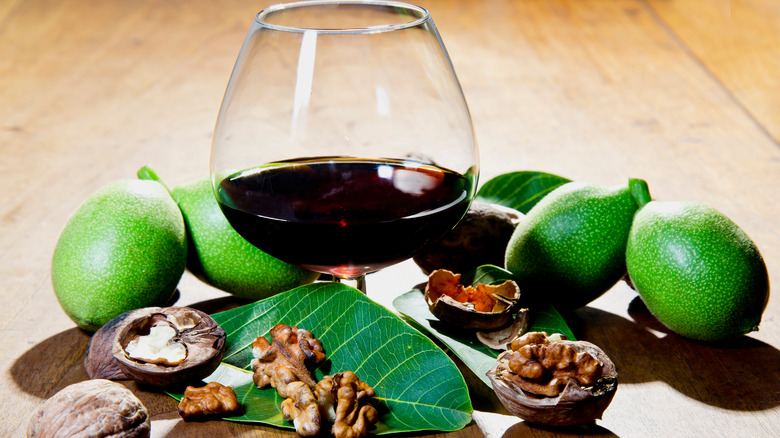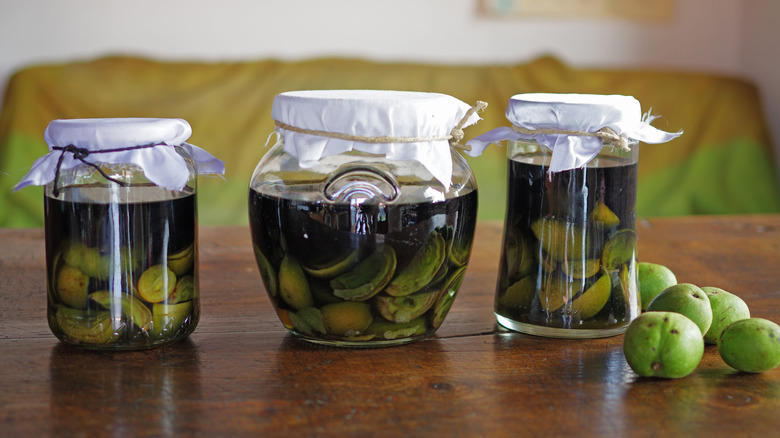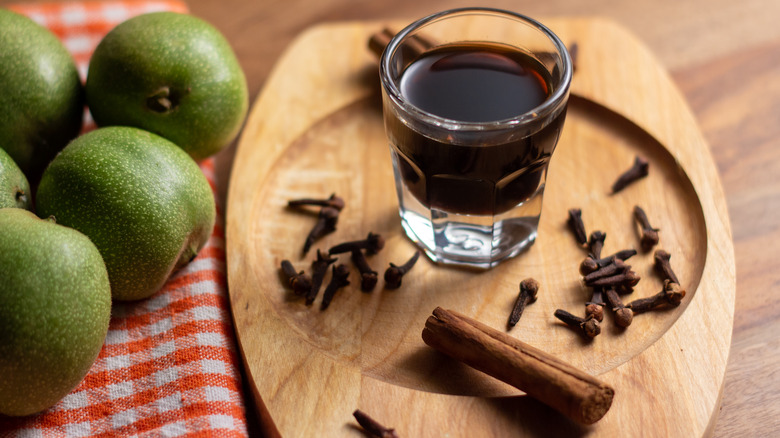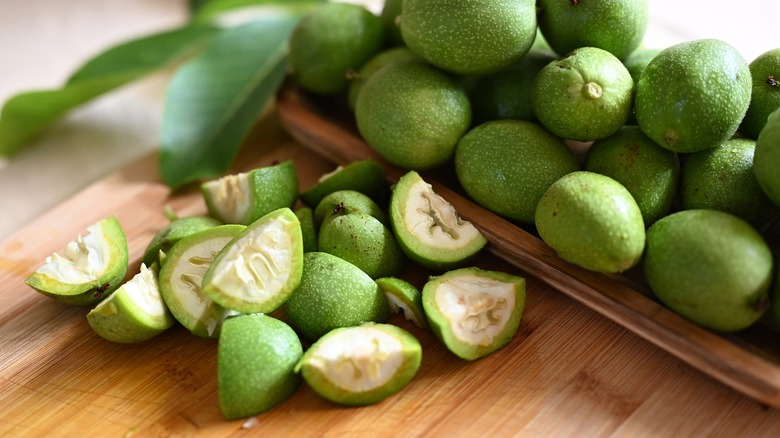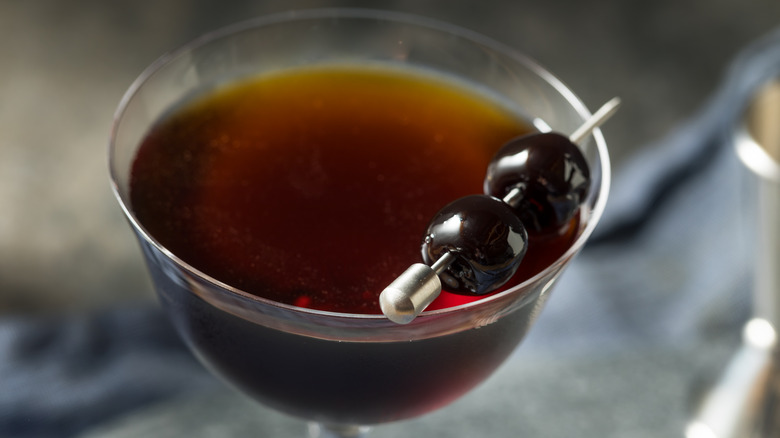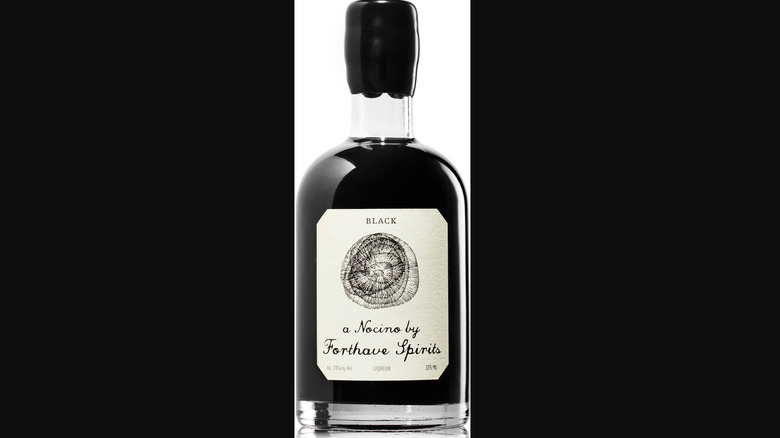What Is Italy's Walnut Liqueur Nocino & How Do You Drink It?
Walnuts have a long and strange history in Italy. While you might not immediately associate the fatty nuts shaped like little brains with Italian cuisine (as pine nuts, hazelnuts, and even chestnuts hog all that glory), they are quite popular in the northern Italian regions of Campania and Emilia-Romagna.
According to PUNCH, the liqueur has a rather mystic history dating back to the 13th century, when barefoot virgins were enlisted to pick the walnuts that make the spirit. Newly married couples in ancient Rome would be pelted with walnuts by their guests to encourage luck and prosperity, and in Benevento in Campania, there is an ancient walnut tree that was said to be a gathering place for witches to perform spells. This association with the supernatural is how walnuts (or noci as they are called in Italian) came to be used as part of an ancient liqueur. This liqueur, still largely unknown in the U.S., is called nocino, and it tastes like Christmas in a bottle.
What is nocino?
Nocino is an Italian liqueur made from green, unripened walnuts. It's considered a digestif and is generally served after dinner with dessert. While the name "nocino" is used in Italy and Italian-speaking parts of Switzerland, several Alpine countries in Europe make an equivalent liqueur, called Noix in France, Nüsse or Nüssenschnaps in Germany and Austria, and Ratafia in Catalonia.
"Nocino has a long history of use in herbal medicine," Daniel de la Nuez of Forthave Spirits explained to us. The Brooklyn-based company is well-acquainted with the history and process for making the drink as it produces a nocino known simply as "Black." He explained, "In the past, it was believed to have a variety of health benefits and was used to treat a range of ailments: as a digestive aid, as an anti-inflammatory tonic. The walnuts contain compounds with anti-inflammatory properties, and the liqueur was often used to relieve pain and inflammation."
What does nocino taste like?
While different brands of nocino have different levels of sweetness and alcohol content, it is generally marked by a complex and spicy nutty flavor. Nocino is light in body but rich in flavor, bitter with a sweet finish and a distinctive earthy, herbal note. While nocino is defined by the flavor of green walnuts, its overall taste depends on the botanicals used by each distiller. The ABV of nocino varies widely depending on the brand, from 24% to 55%. It usually ranges in color from reddish brown to as black as a ripe walnut husk.
As a type of nut liqueur, nocino is closest in flavor to things like amaretto or crème de noyaux, which are produced in Italy and France using the kernels of apricots (which taste like marzipan) or bitter almonds. The well-known Italian liqueur Frangelico is also in this category; it's made with hazelnuts and is also served as a digestif.
How is nocino made?
The first step in making nocino is sourcing walnuts while they are fragrant, and green — appearing almost like limes. They are farmed in the summer, traditionally at the Feast of St. John on June 24, before being macerated (chemically softened with sugar and alcohol) in a process that takes several weeks to months. In Europe, the walnuts are generally macerated for three months, then allowed to ferment for another three, making the liqueur ready just in time for the winter holiday season.
Other producers of nocino, like Forthave Spirits, will macerate and age the liqueur even longer. De la Nuez reveals that he and the other producers "macerate the walnuts in alcohol for nine months [and] after that, we rack off the liquid, sweeten it and let it rest for another nine months in a combination of steel tanks, glass demijohns, and oak barrels." Though the brand's preparation cycle is three times as long as the traditional process, each batch is released all at once just before Christmas every year, keeping with the liqueur's traditional seasonality.
How can you use nocino?
The nutty flavor of nocino plays well with rich and cozy flavors like cherry, apple, cinnamon, and maple. Nocino can be served neat as a digestif with a biscotti — you can even use it to flavor the sweet Italian cookies when baking. It also is great for reducing down a bit to include in or on top of ice cream or gelato, not unlike rum syrup.
For cocktails, nocino is a fabulous swap for Averna amaro in a Black Manhattan, cutting the orange and licorice flavors for its complex sweet nuttiness. Play up the Christmasy notes of nocino in a Walnut Old Fashioned, which uses nocino, calvados, and maple syrup to create the overall impression of drinking an orchard on ice. Or opt for a twist on a Brandy Alexander with a Nocino Alexander, which combines nocino with spiced rum and cream to create something creamy, wintry, and decadent. The Tricolore is another popular nocino cocktail, which uses cream and strawberries for an unconventional cocktail that makes the holiday spirit appropriate for spring.
Where to buy nocino
While nocino has not had the same boom in recent years as various Italian amaros and aperitivos, there is a select movement of American distillers producing this old-fashioned spirit, and it can be found in select cocktail bars with more extensive menus.
There are only a handful of U.S. producers, mostly dotting the east coast, each with their own unique blend and process. Forthave Spirits use a recipe of unique botanicals and foraged Hudson Valley walnuts. The Washington, D.C. distillery Don Ciccio & Figli uses a 1930s recipe from distiller Francesco Amodeo's Italian family to make their nocino, which uses California walnuts and is in stock all year round.In the Midwest, Watershed Distillery and Cardinal Spirits both make modern takes on the nocino as well. But if you're looking for a traditional Italian nocino, look to Azienda Agricola Aggazzotti and Vicario Spirits in Modena, in the Emilia-Romagna region in northern Italy where nocino is popular.
